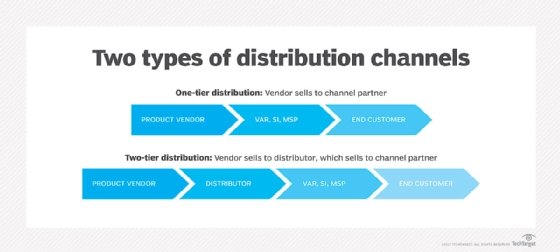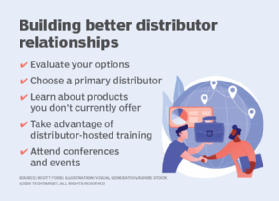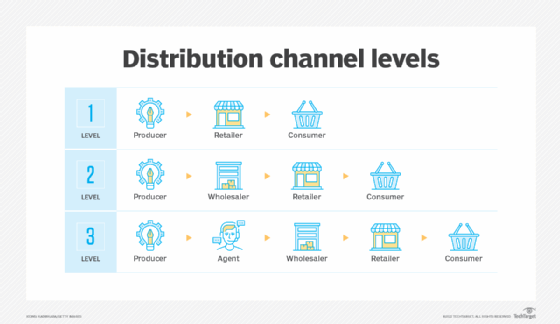distribution channel
What is a distribution channel?
A distribution channel is the network of individuals and organizations involved in getting a product or service from the producer to the customer. Distribution channels are also known as marketing channels or marketing distribution channels.
Types of distribution channels
There are three types of distribution channels: direct, indirect and hybrid.
- Direct. With the direct channel, the company sells directly to the customer. For example, a brewery that brews its own beer and sells it to customers at its own brick-and-mortar location employs a direct channel of distribution. The seller delivers the product or service directly to customers. The vendor might also maintain its own sales force or sell its products or services through an e-commerce The direct channel approach requires vendors to take on the expense of hiring and training a sales team or building and hosting an e-commerce operation.
- Indirect. Indirect channels use multiple distribution partners or intermediaries to distribute goods and services from the seller to customers. Indirect channels can be configured in the following ways:
- With the single-tier distribution model, vendors develop direct relationships with channel partners that sell to the customer.
- In the two-tier distribution model, the vendor sells to distributors that provide products to channel partners, which, in turn, package products for the end customer. Two-tier distribution helps smaller channel partners that would have difficulty establishing direct sales relationships with large vendors.
- Hybrid. Hybrid channels combine the characteristics of direct and indirect channels. The seller uses both direct and indirect methods. For example, a manufacturer might sell an item on its e-commerce website, but then an intermediary delivers the physical product to the customer. The customer still has a direct interaction with the seller, but an intermediary is also involved.

Examples of distribution channel intermediaries
Intermediaries are used in indirect channels to distribute, sell and promote goods and services. Intermediaries may more commonly be referred to as middlemen. Examples of intermediaries include the following:
- Wholesalers are intermediaries between manufacturers and retailers.
- Agents represent a person or entity and serve as an intermediary between buyers and sellers.
- Brokers are similar to agents but represent a person or entity on a limited, per-transaction basis.
- Catalogs are collections of products gathered in a publication and distributed at regular intervals.
- Consultants are individuals who connect distributors with intermediaries lower on the supply chain and give advice on how to distribute product effectively.
- Distributors are in direct contact with the manufacturer but sell to end users.
- Retailers either buy from the manufacturer or another intermediary and distribute to consumers through shops, grocery stores or websites.
- Independent software vendors are vendors that sell their software using a marketplace.
- Managed service providers (MSPs) offer managed software services.
- Online marketplaces are e-commerce sites that connect buyers and sellers.
- Original equipment manufacturers, or OEMs, are companies that sell a product and markets itself as the company that originally manufactured the product.
- Value-added resellers (VARs) are resellers that add value to a product or service before reselling it.
Each type of intermediary represents a channel with its own distinct characteristics. VARs, for example, are often local companies that sell horizontal products, such as office productivity apps or vertical IT products, such as healthcare services to businesses in their geographic region. VARs provide value beyond the original order fulfillment. They're distinct from the manufacturer and customer, and help the product get to the customer with added value.

Systems integrators might be large, national companies that work on highly complex, multivendor IT projects. Consultants might not resell products but rather influence sales through product recommendations to customers.
A vendor develops a marketing strategy called a channel strategy, also known as a distribution channel strategy, to determine what types of intermediaries to target and how to optimize partner relationships to increase sales and improve distribution.
Intensive vs. selective vs. exclusive distribution
There are three main levels of distribution that describe which type of intermediary sells the company's product and how involved the intermediaries are.

This applies to the indirect distribution method, because it involves intermediaries. Indirect product distribution strategies fall into three categories: intensive, selective and exclusive.
- Intensive distribution. This involves a large number of intermediaries. The vendor tries to place its product in as many sales outlets as possible. This method is used with products that have a high consumption frequency and a low cost of production. Examples include common grocery items, such as eggs, bread and potato chips; bathroom products, such as toilet paper; and tobacco products, including cigarettes.
- Selective distribution. This involves a smaller number of intermediaries, using criteria set by the vendor such as geographic region, service and support capabilities. The reputation of the intermediaries is important in this method because vendors need to have a stronger relationship with retailers in order to be selective. For example, a clothing manufacturer might select certain small shops to distribute clothes versus using a large chain.
- Exclusive distribution. This involves only a few intermediaries that agree to exclusively sell the vendor's products. Deals are exclusive and limited to just those intermediaries.
Distribution channel levels explained
Distribution channel levels describe how close an intermediary is to the producer or vendor of a product. With each intermediary added, another level is added between the producer and the customer. If a clothing producer gives products to a retailer to sell to customers, there's one level between the producer and customer. If the producer first gives the clothing to a wholesaler to then give to a retailer and then the customer, there are two levels between producer and consumer. Adding another level might involve placing an agent between producer and wholesaler, to help find the wholesaler.

The alcohol industry is a good example of a distribution channel with multiple levels. There are laws that require wineries to first sell their products to a wholesaler before selling to a retailer. Direct-to-consumer models like e-commerce are examples of low-level, short distribution channels. For example, customers can buy products directly from producers on Amazon.
Partner enablement
As vendors grow the size and scope of their distribution network, dedicated resources are often needed to ensure the success of the partner program. Reporting to the heads of sales or marketing, partner enablement managers are focused on the success of the partner program.
Partner enablement includes the creation of co-branded sales and marketing material and the training of partners' sales and marketing staff. The partner enablement manager facilitates communication and collaboration between the partners and assorted stakeholders and executives on the vendor side. The partner enablement manager also creates a partner certification program, which defines tiers of certification, along with the requirements to meet each tier.
The importance of distribution channels
The various channels of distribution play a critical role in a vendor's go-to-market strategy. If successfully executed, any distribution channel model -- whether focused entirely on one mode, such as direct sales, or embracing multiple outlets, such as multichannel distribution -- can open or expand markets, exceed sales goals and grow a vendor's bottom line.
Beyond boosting revenue, distribution channels can also broaden the portfolio of products and services available to customers. VAR, SI and MSP channel partners, for instance, often provide consulting, technology implementation services and post-sales support. They might also incorporate a vendor's product into an integrated IT product.
The final customer is focused on whether a product or service meets its needs. The customer is often unaware or unconcerned about the intricacies of distribution channels.
Having a working go-to-market strategy with trustworthy distribution partners is important in supply chain management. Learn about the risks that come with the supply chain, and what companies can do to avoid falling behind.




